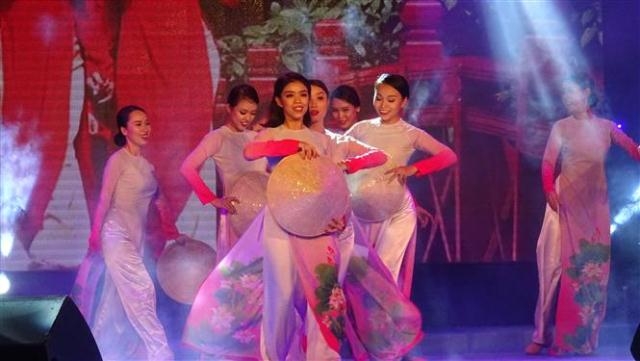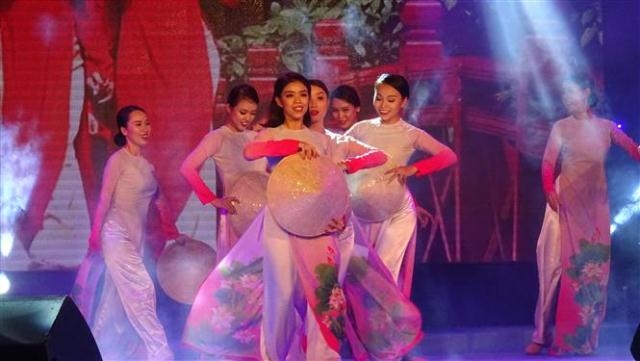
A trade and culture exchange programme among ASEAN nations opened at Ho Chi Minh City’s September 23 Park on April 18.

A performance of Vietnamese girls with ao dai (traditional long dress) and conical hats at the exchange programme. (Photo: VNA)
The event, hosted by the municipal People’s Committee, is to mark Vietnam’s 43rd Reunification Day (April 30) and the third founding anniversary of the ASEAN Economic Community.
Speaking at the opening ceremony, Vice Chairman of the municipal People’s Committee Le Thanh Liem said over the past 50 years, ASEAN has become a unified community with a common vision and identity.
Easier flows of traffic and frequent economic and cultural activities between members with a population of nearly 630 million people have brought the countries closer, he added.
The exchange programme offers opportunities for people in ASEAN to introduce their cultural and historical values to international friends, bolstering mutual understanding and solidarity and contributing to a sustainable, self-strengthening and dynamic ASEAN Socio-Cultural Community.
The official voiced his hope that through the event, ASEAN businesses will seek more cooperation and optimise economic benefits brought by the ASEAN Community. He also encouraged ASEAN firms to join hands to create made-in ASEAN products.
The programme, which runs until April 22, includes a fair with more than 110 trade pavilions and 40 cuisine booths.
Art, martial arts, folk games and sport performances are also being held during the event, together with the screening of clips promoting tourism of participating countries and products of enterprises.
Source: NDO
With an increasingly vibrant and widespread emulation movement aimed at building cultured residential areas and cultured families, Yen Thuy District has been making steady progress toward improving both the material and spiritual well-being of its people, while fostering a civilized, prosperous, beautiful, and progressive community.
Once lacking recreational spaces and community facilities, Residential Group 2 in Quynh Lam Ward (Hoa Binh City) has recently received attention for the construction of a new, spacious, and fully equipped cultural house. The project followed the model of state support combined with public contributions in both labor and funding.
The "All people unite to build cultural life" movement, which has been effectively integrated with Kim Boi district’s socio-economic development goals, is fostering a lively spirit of emulation across local residential areas, hamlets, villages, public agencies, and enterprises. In addition, through the initiative, traditional cultural values are being preserved and promoted, while community solidarity and mutual support in poverty reduction and economic development are being strengthened.
A working delegation of the Hoa Binh provincial People’s Committee led by its Permanent Vice Chairman Nguyen Van Toan on June 11 inspected the progress of a project to build the Mo Muong Cultural Heritage Conservation Space linked to tourism services in Hop Phong commune, Cao Phong district.
Born and growing in the heroic land of Muong Dong, Dinh Thi Kieu Dung, a resident in Bo town of Kim Boi district, in her childhood was nurtured by the sweet lullabies of her grandmother and mother. These melodies deeply imprinted on her soul, becoming an inseparable part of her love for her ethnic group's culture. For over 20 years, this love for her hometown has driven Dung to research, collect, and pass down the cultural values of the Muong people to future generations.
In the final days of May, the Ethnic Art Troupe of Hoa Binh Province organized performances to serve the people in remote, mountainous, and particularly disadvantaged areas within the province. These were not just ordinary artistic shows, but they were the meaningful journeys aimed at spreading cultural values, enhancing the spiritual life of the people and contributing to the preservation of ethnic minority cultural identities.



